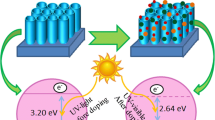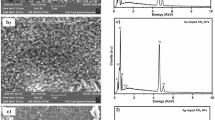Abstract
Zn-doped titanium oxide (TiO2) nanotubes electrode was prepared on a titanium plate by direct anodic oxidation and immersing method in sequence. Field emission scanning electron microscopy (FESEM) showed that the Zn-doped TiO2 nanotubes were well aligned and organized into high density uniform arrays with diameter ranging from 50 to 90 nm. The length and the thickness were about 200 and 15 nm respectively. TiO2 anatase phase was identified by X-ray diffraction (XRD). X-ray photoelectronspectroscopy (XPS) indicated that Zn ions were mainly located on the surface of TiO2 nanotubes in form of ZnO clusters. Compared with TiO2 nanotubes electrode, about 20 nm red shift in the spectrum of UV-vis absorption was observed. The degradation of pentachlorophenol (PCP) in aqueous solution under the same condition (initial concentration of PCP: 20 mg/L; concentration of Na2SO4: 0.01 mol/L and pH: 7.03) was carried out using Zn-doped TiO2 nanotubes electrode and TiO2 nanotubes electrode. The degradation rates of PCP using Zn-doped TiO2 nanotubes electrode were found to be twice and 5.8 times as high as that using TiO2 nanotubes electrode by UV radiation (400 μw/cm2) and visible light radiation (4500 μw/cm2), respectively. 73.5% of PCP was removed using Zn-doped TiO2 nanotubes electrode against 48.5% removed using TiO2 nanotubes electrode in 120 min under UV radiation. While under visible light radiation, the degradation efficiency of PCP was 18.4% using Zn-doped TiO2 nanotubes electrode against 3.2% using TiO2 nanotubes electrode in 120 min. The optimum concentration of Zn doping was found to be 0.909%. The PCP degradation efficiencies of the 10 repeated experiments by Zn-doped TiO2 nanotubes electrode were rather stable with the deviation within 3.0%.
Similar content being viewed by others
References
Mills A, Le Hunte S. An overview of semiconductor photocatalysis. J Photoch Photobio A: Chem, 1997, 108(1): 1–35
Xi B D, Liu C X, Kong X, et al. Decomposition of aqueous sodium pentachlorophenolate (PCP-Na) by using TiO2 coating photocatalyst. Environ Sci (in Chinese), 2001, 22(1): 41–44
Wang H Y, Jiang Z P, Yu G, et al. Study of photoelectrocatalytic oxidation of benzoic acid. Environ Sci (in Chinese), 2004, 25(1): 25–29
Prevot A B, Vincenti M, Bianciotto A, et al. Photocatalytic and photolytic transformation of chloramben in aqueous solutions. Appl Catal B: Environ, 1999, 22(2): 149–158
Vinodgopal K, Kamat P V. Electrochemically assisted photocatalysis using nanocrystalline semiconductor thin films. Sol Energ Mat Sol C, 1995, 38(14): 401–410
Choi W, Termin A, Hoffmamm M R. The role of metal ion dopants in quantum-sized TiO2: Correlation between photoreactivity and charge carrier recombination dynamics. J Phys Chem, 1994, 98(51): 13669–13679
Kamat P V. Photophysical, photochemical and photocatalytic aspects of metal nanoparticles. J Phys Chem B, 2002, 106(32): 7729–7744
Quan X, Yang S G, Yuan X L, et al. Preparation of titania nanotubes and their environmental applications as electrode. Environ Sci Technol, 2005, 39(10): 3770–3775
Yu X B, Wang G H, Luo Y Q, et al. Preparation of TiO2 complex particles doped metal ions and their photocatalytic reactivity for the degradation of tetracycline. J Shanghai Norm Univ (Nat Sci) (in Chinese), 2000, 29(1): 75–82
Wilke K, Breuer H D. The infuence of transition metal doping on the physical and photocatalytic properties of titania. J Photoch Photobio A: Chemistry, 1999, 121(1): 49–53
Luan Y, Fu P F, Dai X G, et al. Effects of metal ion dopants on TiO2 photocatalysis. Prog Chem (in Chinese), 2004, 16(5): 738–746
Li X Z, Li F B. Study of Au/Au3+-TiO2 photocatalysts toward visible photooxidation for water and wastewater treatment. Environ Sci Technol, 2001, 35(11): 2381–2387
Author information
Authors and Affiliations
Corresponding author
Additional information
Supported by the National Natural Science Foundation of China (Grant No. 20407005), and the Hi-Tech Research and Development Program of China (Grant No. 2004AA649290)
About this article
Cite this article
Zhao, H., Chen, Y., Quan, X. et al. Preparation of Zn-doped TiO2 nanotubes electrode and its application in pentachlorophenol photoelectrocatalytic degradation. CHINESE SCI BULL 52, 1456–1461 (2007). https://doi.org/10.1007/s11434-007-0170-8
Received:
Accepted:
Issue Date:
DOI: https://doi.org/10.1007/s11434-007-0170-8




